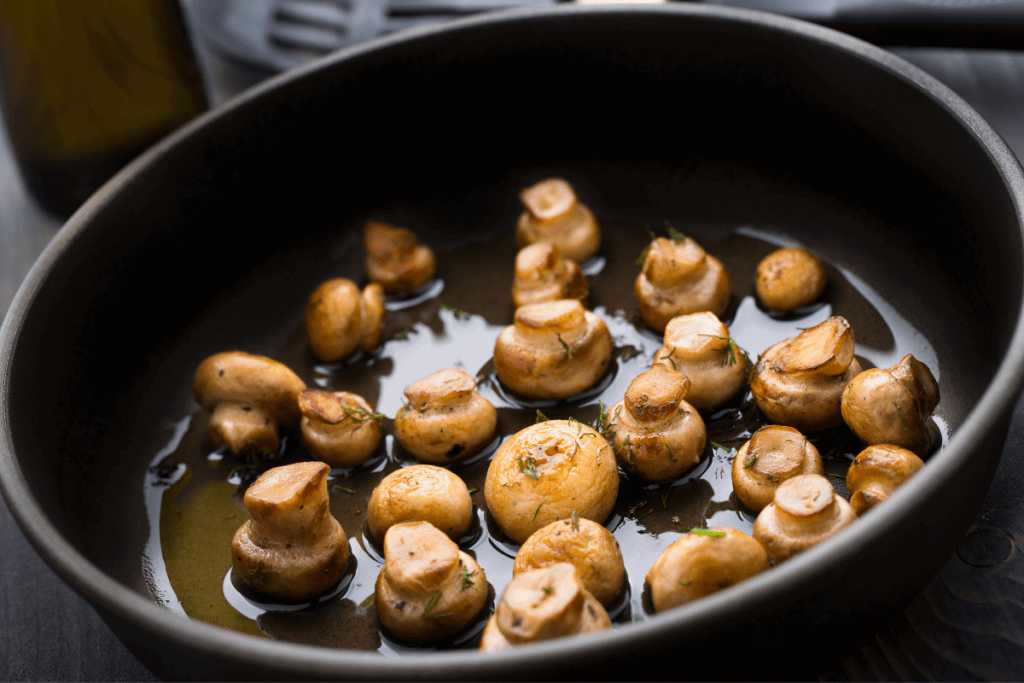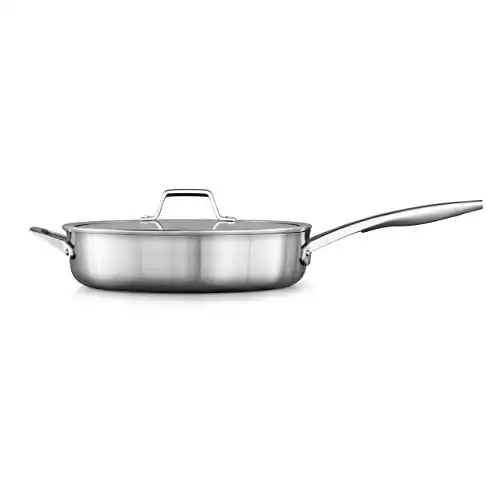The difference between a skillet and a saute pan comes primarily down to the shape and height of the sides. Saute pans have straight sides, while a skillet (aka frying pan) has short flared ones.
It may seem like a minor difference, but it has a huge effect on cooking performance. I’m going to use my decade-plus of professional cooking experience to help you understand when and why to reach for a skillet vs. a saute pan.
In This Article
Saute Pan: Calphalon 5-Quart Saute Pan
A saute pan is a multitasking workhorse that can handle one-pot meals or braises but can also be used to sear a steak, or make fried chicken.
The Calphalon 5-quart model (pictured above) is a perfect example of what a good saute pan should be. It has a large, flat, 14-inch cooking surface. That’s plenty of room to cook for a large group, and enough surface area to sear meat without crowding the pan.
The tall, but not too tall, sides of a saute pan are another key feature. The Calphalon model has 4.5-inch sides. Tall enough to hold a substantial amount of food and liquid, but shallow enough that you can still effectively reduce a sauce or sear a piece of meat.
The higher sides of a saute pan make a lid a useful accessory, and they usually come standard with most models. Just another reason this is one of the best multitaskers around.
What we like
- Tall side walls can hold large amounts of food and liquid
- Large cooking surface
- A lid adds versatility and enables longer cook times
What We don’t
- Can be quite heavy
- Harder to maneuver and toss ingredients in the pan
Frying Pan: All-Clad D3 10-Inch Frying Pan
A frying pan is an indispensable piece of cookware that you’ll find in just about every kitchen. It’s one of the best choices for stir-frying, searing meat, cooking fish, or frying an egg.
The All-Clad D3 10-inch frying pan is close to a perfect specimen. It’s what you’ll find in professional kitchens around the world, and is one of my go-to’s at home.
It’s typical for a frying pan to be a bit smaller than a saute pan. They’re usually used for hot and fast cooking, and are not designed to hold huge amounts of food.
Good frying pans have a flat, wide cooking surface, just like a saute pan. But, the sides are much shorter and they flare out in a gentle slope. That makes them perfect for a quick stir fry where flipping and tossing ingredients in the pan is necessary.
The shallow sides also give better access when using a spatula to flip an item, and it allows you to very quickly reduce liquids in the pan.
When it comes to quick cooking and maneuverability, this option can’t be beat.
What we like
- Good spoon and spatula access for stirring and flipping
- Sloped sides make tossing ingredients easy
- Shallow sides are great for quickly reducing liquids
What We don’t
- Not great for holding large amounts of food or liquid
- Not the best choice for dishes that require long cook times
Head to Head Comparison
Design And Shape
The design and shape of a saute pan and skillet are what make them function so differently. Both are round and have a flat cooking surface, but that’s about where the similarities end.
Saute Pan
Sauté pans have a flat cooking surface that runs into a straight sidewall that’s usually between 3 and 5 inches tall. The large cooking surface is great for searing, and the tall sidewalls allow you to cook and hold large amounts of food or liquid.
That makes this option great for one-pan meals, braises, shallow frying, or anything else that requires more liquid and a longer cook time.
Skillet
Skillets also have a flat cooking surface but the sides are very short and gradually slope up and flare out. That makes them perfect for tossing ingredients and quick evaporation.
A skillet is the best choice for hot and fast stir-frying, searing meat and fish, or frying eggs.
Pan Size
Saute pans and skillets come in a wide range of sizes. But, there are some key differences that come into play when deciding what’s best for you.
Saute Pan
Sauté pans are usually sized by the quart, and are typically available in options between 3 and 6-quarts. A good rule of thumb when picking a size is that each quart will feed approximately one person.
For example, a 5-quart saute pan should feed between 4 and 6 people. But, everyone’s appetite is different, so plan accordingly.
Skillet
Skillets, on the other hand, are almost always measured by the pan’s diameter across the top of the pan. 8-inch, 10-inch, and 12-inch skillets are the most common sizes that you’ll find.
8-inch skillets are great egg pans and can fit a single chicken breast or piece of fish. If you’re cooking for one, this size will suffice. But, it’s definitely on the small side and can limit the usefulness of your pan.
I find skillets that are around 10-inches to be the perfect daily drivers. You can still use these for eggs, and it’s big enough for a few chicken breasts, a couple of steaks, or stir-fries for up to four people.
A 12-inch skillet can be big and cumbersome if you’re only cooking for a couple of people. But, for feeding a family of 4 or more, this is a great pan to have on hand.
Pan Material
Pan material plays a huge role in how and what it can be used for. Not to mention how long it’s going to last and if you’ll have to put in any additional work to keep it functioning at its best.
Saute Pan
Saute pans almost always come down to two choices: Stainless steel or nonstick.
If convenience and ease of use are important to you, a nonstick saute pan might be the right choice. The downside to nonstick pans is that they lack durability and are not as well suited for searing and caramelization because of the temperature limitations of Teflon.
Stainless steel is the more versatile option here. For one, it’s very durable. That means it’s going to last longer and you can use metal utensils without worrying about damaging the cooking surface. Plus, it’s a great material for searing and caramelization.
Skillet
We’re spoiled for choice when it comes to skillet material options.
Just like with saute pans, a nonstick skillet is a good choice for convenience and ease of use. I have one and I use it almost exclusively as an egg pan.
Stainless steel options like the All-Clad 10-inch frying pan are durable and easy to take care of. But they can take a little getting used to.
A cast-iron skillet is definitely one of my cookware essentials. But, I think it deserves its own category as it falls somewhere between a saute pan and a skillet.
The last option is a carbon steel skillet. These pans have a classic frying pan shape but are made from a material similar to cast iron. They’re another one of my favorite pans to cook with, but they do require some maintenance to keep them from rusting.
Weight
Saute pans are much taller than skillets. That means there’s more material used in making them and that makes saute pans heavier in general.
Since saute pans aren’t designed to toss and flip ingredients, the extra weight isn’t usually a big deal. Skillets, on the other hand, are made to be maneuverable and easy to handle with one hand.
Handle
Sturdy handles are a key component of any good piece of cookware.
Saute Pan
The handles on a saute pan must be large and very securely attached. This is extremely important when you consider how heavy they can be when full of food.
Larger models like the Calphalon saute pan will also have a sturdy helper handle. Something that comes in very handy, especially when pulling a steaming hot braise from the oven.
Skillet
Skillets should also have a long handle that’s securely attached and comfortable to hold. These are often slightly curved or angled like the All-Clad D3 model.
That curve or angle is helpful when grabbing and maneuvering the pan on a full stovetop. And, it gives leverage that makes tossing ingredients in the pan feel smooth and natural.
Evaporation
Saute pans have very tall sides compared to a skillet. This is one of the reasons a saute pan is so good for one-pot meals and other dishes that contain a lot of liquid.
It allows you to hold more food, and slows evaporation, keeping more moisture in the pan. But, because they still have such a wide cooking surface, you can still effectively reduce a sauce when needed.
A skillet is all about the wide cooking surface and low sides. They’re not meant to hold large volumes of food. Instead, the short sides allow you to toss ingredients well and reduce liquids incredibly fast.
So, Which One Is For You?
Choosing between a skillet and saute pan isn’t easy or clear cut. There’s a lot of confusion between the two, and many people use the two titles interchangeably. Then, you throw a cast iron skillet into the mix which looks just like a saute pan, and we’re back to square one.
So, here’s a simple way to choose which pan to choose and when.

Choose A Saute Pan If:
- You’re cooking food with a lot of liquid
- You’re cooking something for a long period of time and want slower evaporation
- You’re frying, braising, poaching, or making one pot meals that require taller sides

Choose A Skillet If:
- You need easy access with a spatula for flipping (i.e. eggs or fish)
- You want shallow sides for quickly reducing liquid
- You’ll be making stir fries that require tossing and flipping
Both pans are great multitaskers. If you have the space, each one deserves a spot in your kitchen.
The Calphalon 5-quart saute pan is an ideal option that’s great when it comes to cooking for a family. Plus, it’s built to last.
For the best skillet around, the All-Clad D3 10-inch skillet is the way to go. It’s incredibly durable, and offers some of the most even heat distribution around.
To see how each of these pans stack up against the competition, check out my full breakdowns of the best saute pans and the best skillets on the market.









